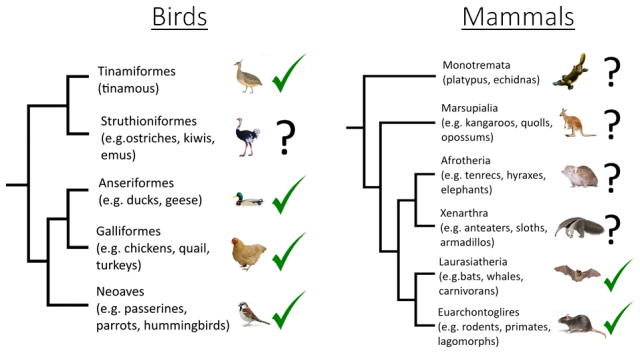Animals in urban environments face many unique challenges including finding and adapting to new sources of food, coping with almost continual human disturbance, and learning to avoid introduced predators (domestic cats I’m looking at you).
Another factor that all animals in urban habitats must learn to cope with is noise. Noise in cities comes primarily from cars and other road vehicles, but is also produced by factories, building sites, roadworks and numerous other human activities. In my own experiments I have measured noise levels in excess of 70 dB next to major city roads. For comparison, that’s as loud as a vacuum cleaner from 3 metres (10 feet) away! Even in quieter areas and at the quietest times of day urban noise rarely dips below 50 dB which is around the same level as in a bustling office.

For animals in urban environments there is almost no escape from noise. This presents a major problem for species which use sound to communicate as their calls and signals can easily be drowned out and lost in the din of the city. However, as is often the case in nature animals have found a solution to this problem and it is surprisingly simple.
In noisy environments many species, including all mammals and birds so far tested, unconsciously increase the amplitude of their vocal signals to ensure they are heard. This response to noise is known as the Lombard effect, named after its discoverer the French scientist and doctor Étienne Lombard (1869 – 1920).

Surprisingly however, despite numerous studies of the Lombard effect in many different species very little is known about how quickly the Lombard effect acts after sudden increases in noise. For city dwellers the ability to respond to changes in noise levels quickly may be vital as things such as passing vehicles or sporadic building or road works can cause noise levels can fluctuate wildly over the course of a day. Even in wilderness habitats noise levels can change quickly due to wind, rain or the even the calls of other animals.

Last year my colleagues and I set out to fill this gap in our knowledge by testing how fast a songbird could exhibit the Lombard effect when noise levels suddenly changed. As a test species we used wild-type canaries. This species was perfect for our study as canaries sing a lot with little encouragement and produce really long and complex songs. These songs are composed of long strings of repeated bursts of sound known as song elements which can be grouped into different element types.

Here you can listen to the song of one of the canaries from our experiment while the image shows a visualisation of song and song elements.

To test how quickly canaries could respond to noise we created software which would detect when a canary began to sing, then play a 20 second burst of 75 dB white noise after a random delay of between 5-10 seconds. In this way the first half a canary’s song was sung during quiet conditions while the other half was overlapped by noise which caused the bird to respond by singing louder.
In this recording you can hear how song sounds when overlapped halfway through by white noise.

Using recordings we were able to work out the strength of the Lombard effect in our canaries by comparing how loud they sang before and after noise began.
We found that in comparison to song elements sung during quiet conditions, song elements sung during the 20 second white noise playbacks were 5.3 dB louder on average. That may not sound like much, but is actually an impressive 84 % increase in song amplitude.
To work out how fast this increase in song amplitude occured we used a statistical technique known as broken-line regression. Using this method we were able to work out exactly how quickly the amplitude of song increased after noise began, and it was extremely fast. Our canaries were able to respond to noise extremely quickly. After just 0.32 seconds of noise exposure their song showed a statistically significant increase in amplitude.

Our study shows that canaries are able to rapidly increase the amplitude of their song in response to sudden increases in background noise levels. This means that, despite fluctuating and unpredictable changes in noise levels, canaries can ensure that their songs ares till heard. This ability is likely to be particularly useful in urban areas where noise from anthropogenic sources is loud, fluctuating and unpredictable. Given that the Lombard effect is known in all other birds so far tested it is highly likely that other species also possess this ability.
This study is published in the Journal of Experimental Biology and is available here.
If you don’t have access to the journal but would like a copy of the article let me know and I will send you a copy.



 Remarkably however, this is just one of
Remarkably however, this is just one of 


